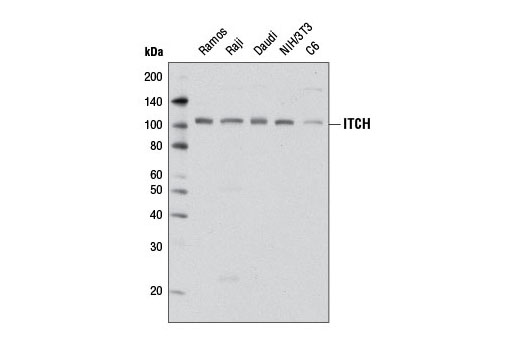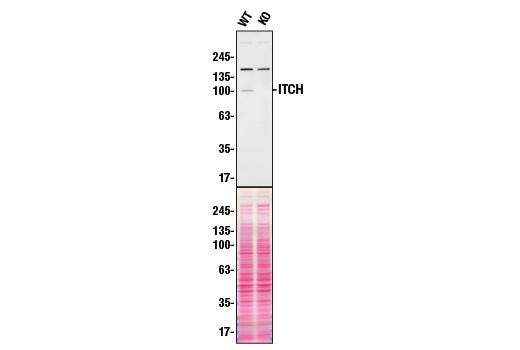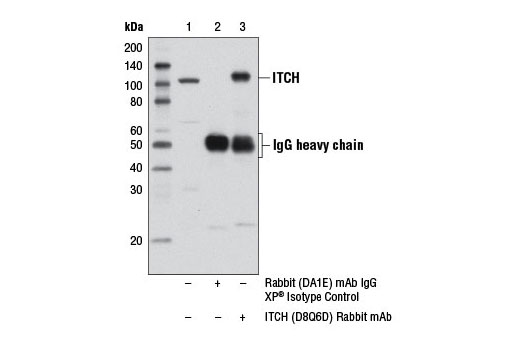WB, IP
H M R
Endogenous
105
Rabbit IgG
#Q96J02
83737
Product Information
Product Usage Information
| Application | Dilution |
|---|---|
| Western Blotting | 1:1000 |
| Immunoprecipitation | 1:200 |
Storage
Specificity / Sensitivity
Species Reactivity:
Human, Mouse, Rat
Source / Purification
Monoclonal antibody is produced by immunizing animals with a synthetic peptide corresponding to residues surrounding Asp125 of human ITCH protein.
Background
ITCH is a HECT domain-containing E3 ubiquitin ligase, first identified in genetic studies of the mouse agouti locus, in which mutations result in characteristic coat color changes. One particular agouti mutation (non-agouti-lethal 18H) is notable for the development of immunological defects not observed in other agouti mutant mice; these include lymphoid hyperplasia and chronic stomach, lung and skin inflammation (manifest as constant itching). The 18H agouti mutation was traced to a chromosomal inversion that disrupted expression of an adjacent gene in the agouti locus, subsequently termed Itch to reflect the chronic itching phenotype (1-3).
Further characterizations revealed that Itch encoded a NEDD4-like E3-ubiquitin ligase capable of catalyzing Lys29, Lys48, and/or Lys63-linked ubiquitination of target proteins, leading to their degradation by the proteosome pathway (4-6). The distinct phenotypes of Itch mutant mice led to the identification of an important regulatory role for ITCH-mediated ubiquitination in inflammatory signaling pathways. For example, ITCH-mediated ubiquitination of the transcription factor JunB was shown to play a direct inhibitory role in regulating expression of the proinflammatory cytokine IL-4. ITCH-null T lymphocytes consequently exhibit increased production of IL-4, leading to biased differentiation of naive CD4+ cells towards the proinflammatory Th2 lineage (7). In accordance with the findings from mutant Itch mouse models, a genetic linkage study in humans identified loss-of-function mutations in ITCH as a direct cause of syndromic multisystem autoimmune disease (SMAD) (8).
Notably, targets of ITCH-mediated ubiquitination are not restricted to immune signaling pathways. For example, key mediators of the Hedgehog (9,10), Wnt/β-catenin (11), Hippo (12), and Notch signaling pathways (13,14) have been identified as important targets of ITCH-mediated ubiquitination (2).
- Matesic, L.E. et al. (2008) Curr Top Microbiol Immunol 321, 185-200.
- Melino, G. et al. (2008) Cell Death Differ 15, 1103-12.
- Perry, W.L. et al. (1998) Nat Genet 18, 143-6.
- Chastagner, P. et al. (2006) EMBO Rep 7, 1147-53.
- Lee, T.L. et al. (2008) Biochem Biophys Res Commun 375, 326-30.
- Ahmed, N. et al. (2011) Nat Immunol 12, 1176-83.
- Fang, D. et al. (2002) Nat Immunol 3, 281-7.
- Lohr, N.J. et al. (2010) Am J Hum Genet 86, 447-53.
- Di Marcotullio, L. et al. (2006) Nat Cell Biol 8, 1415-23.
- Di Marcotullio, L. et al. (2011) Oncogene 30, 65-76.
- Wei, W. et al. (2012) Mol Cell Biol 32, 3903-12.
- Salah, Z. et al. (2011) Cancer Res 71, 2010-20.
- Qiu, L. et al. (2000) J Biol Chem 275, 35734-7.
- McGill, M.A. and McGlade, C.J. (2003) J Biol Chem 278, 23196-203.
Species Reactivity
Species reactivity is determined by testing in at least one approved application (e.g., western blot).
Western Blot Buffer
IMPORTANT: For western blots, incubate membrane with diluted primary antibody in 5% w/v nonfat dry milk, 1X TBS, 0.1% Tween® 20 at 4°C with gentle shaking, overnight.
Applications Key
WB: Western Blotting IP: Immunoprecipitation
Cross-Reactivity Key
H: human M: mouse R: rat Hm: hamster Mk: monkey Vir: virus Mi: mink C: chicken Dm: D. melanogaster X: Xenopus Z: zebrafish B: bovine Dg: dog Pg: pig Sc: S. cerevisiae Ce: C. elegans Hr: horse GP: Guinea Pig Rab: rabbit All: all species expected
Trademarks and Patents
使用に関する制限
法的な権限を与えられたCSTの担当者が署名した書面によって別途明示的に合意された場合を除き、 CST、その関連会社または代理店が提供する製品には以下の条件が適用されます。お客様が定める条件でここに定められた条件に含まれるものを超えるもの、 または、ここに定められた条件と異なるものは、法的な権限を与えられたCSTの担当者が別途書面にて受諾した場合を除き、拒絶され、 いかなる効力も効果も有しません。
研究専用 (For Research Use Only) またはこれに類似する表示がされた製品は、 いかなる目的についても FDA または外国もしくは国内のその他の規制機関により承認、認可または許可を受けていません。 お客様は製品を診断もしくは治療目的で使用してはならず、また、製品に表示された内容に違反する方法で使用してはなりません。 CST が販売または使用許諾する製品は、エンドユーザーであるお客様に対し、使途を研究および開発のみに限定して提供されるものです。 診断、予防もしくは治療目的で製品を使用することまたは製品を再販売 (単独であるか他の製品等の一部であるかを問いません) もしくはその他の商業的利用の目的で購入することについては、CST から別途許諾を得る必要があります。 お客様は以下の事項を遵守しなければなりません。(a) CST の製品 (単独であるか他の資材と一緒であるかを問いません) を販売、使用許諾、貸与、寄付もしくはその他の態様で第三者に譲渡したり使用させたりしてはなりません。また、商用の製品を製造するために CST の製品を使用してはなりません。(b) 複製、改変、リバースエンジニアリング、逆コンパイル、 分解または他の方法により製品の構造または技術を解明しようとしてはなりません。また、 CST の製品またはサービスと競合する製品またはサービスを開発する目的で CST の製品を使用してはなりません。(c) CST の製品の商標、商号、ロゴ、特許または著作権に関する通知または表示を除去したり改変したりしてはなりません。(d) CST の製品をCST 製品販売条件(CST’s Product Terms of Sale) および該当する書面のみに従って使用しなければなりません。(e) CST の製品に関連してお客様が使用する第三者の製品またはサービスに関する使用許諾条件、 サービス提供条件またはこれに類する合意事項を遵守しなければなりません。


